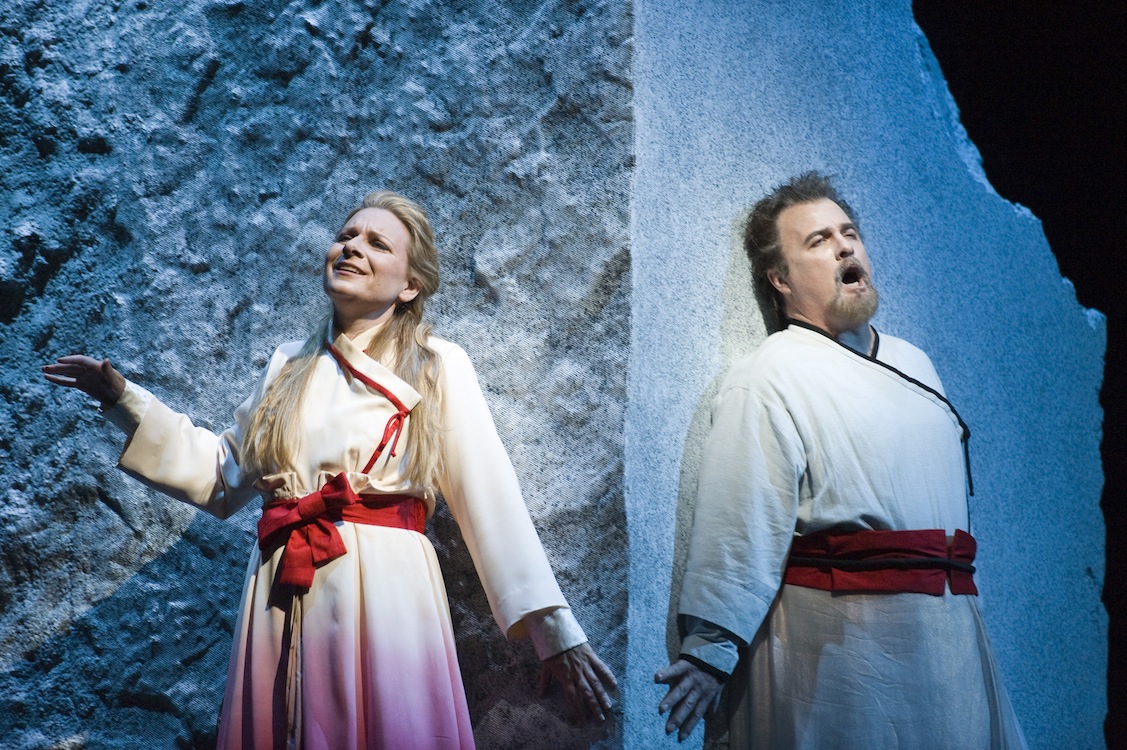After a scary start, musical values conquer wayward production in Seattle’s new “Tristan”

Annalena Persson as Isolde and Clifton Forbis as Tristan in Seattle Opera's new Wagner production. Photo: Rozarii Lynch
Expectations were high when Seattle Opera announced a new production of Wagner’s Tristan und Isolde: the last go-round in 1998 paired Jane Eaglen and Ben Heppner for what one San Francisco reviewer called “a titanic Tristan.”
Filling Eaglen’s and Heppner’s shoes is a formidable job, and the new Seattle Tristan is not quite titanic. It isn’t a sinking Titanic either, however, boasting an impressive cast and the lyrical hand of conductor Asher Fisch in the McCaw Hall orchestra pit.
For sheer decibel levels, you’ll have to go a long way to beat the leading singers assembled by company general director Speight Jenkins. Swedish soprano Annalena Persson, making her U.S. debut as Isolde, was paired with tenor Clifton Forbis, a veteran Tristan who made his Seattle debut as Cavaradossi in 2001.
These singers, and the rest of the cast, have voices with the requisite Wagnerian heft; at times, as in the duets, an almost overwhelming volume of sound sweeps out from the stage and into the house.
Persson is an attractive singer who looks right as Isolde, but the first 15 minutes or so of the opening-night Act I were terrifying as she struggled to get ahold of her voice. The wobble was so wide that it was difficult to tell which note she was trying to sing. After that, however, the soprano steadied, and the rest of the singing was commendable – though the Liebestod lacked some of the emotional intensity that makes it such a satisfying ending to this epic score.
Forbis, a sturdy and reliable Tristan, had a hard time finding a middle ground between an utterly tremendous bellow and the voice-saving “coast” mode (mainly employed in Act I, which was more muttered than declaimed). He rose to real heroism, however, in the tenor-killing Act III, in which his passionate longing for Isolde was convincing and compelling.
Regulars in Seattle Opera’s Ring and other Wagnerian productions completed the cast – and none of them disappointed the eager Tristan audience. Greer Grimsley, the Wotan of the current Seattle Ring production, made an affecting and resonant Kurwenal. Margaret Jane Wray’s gleaming, powerful soprano gave the handmaiden role of Brangäne unusual impact. And Stephen Milling was almost too good as King Marke; you could almost see the audience approval rating for Tristan and Isolde dropping like a stone, for betraying such a noble, empathetic man whose pain and decency were made so real. Simeon Esper (Sailor/Shepherd) and Jason Collins (Melot) made the most of their roles’ opportunities.
In the orchestra pit, seasoned Wagnerian Asher Fisch did wonders with the sensuous score, giving it the rich colors and surging emotion without ever overwhelming the singers. Kudos to English horn player Stefan Farkas and to trumpeter Justin Emerich, whose “holztrompete” was particularly effective in Act III.
This Tristan is not as easy on the eye as on the ear. Designed by Robert Israel (whose postmodern 1980s Ring was one of his more controversial Seattle productions), and directed by company regular Peter Kazaras, the show’s intent is said to be an exploration of “Tristan time” that “reaches back and forth into different dimensions, of the magnification of time.” Well, perhaps, but the one thing you’re not looking for in a five-hour opera is the “magnification of time.”
What happened instead is a drama in which Tristan and Isolde’s big Act II tryst, in which they are consumed by violent passion for each other, was expressed by an extremely slow, stately walk about the set during which the two lovers didn’t look at each other or touch each other. Tristan runs his hand tenderly over the surface of a block-like boulder from which he earlier emerged (courtesy of some nifty lighting effects), but he does not so much as hold hands with the woman with whom he is frantically besotted. It’s curious, to say the least.
Israel’s set, with its spare, rectangular spaces and stage-front row of stairs (on which the singers often sit), features what appears to be a long clothesline with a sheet over it, behind which some of the action takes place. The singers wear strange kimono-like garments that tie on the sides. Near the end of the opera, when Isolde’s ship finally comes into view, Kurwenal depicts the arrival by hoisting a little model ship overhead, an act that several audience members apparently found risible.
Still, when musical values are paramount, the audience is mostly well served in Seattle Opera’s new Tristan und Isolde.
Seattle Opera’s Tristan und Isolde runs through August 21. www.seattleopera.org; 800-426-1619.
Posted Aug 02, 2010 at 12:41 am by operafan
Your review is right on target. I found myself totally captivated by the music and mostly satisfied with the singing. However the set and staging were ridiculous — a shower curtain hanging perpetually in the middle of the stage? A red laser light? Not to mention the oddly arranged furniture. No wonder Kazaras and Israel were booed after opening night performance. This opera is just as good with your eyes closed.
Posted Aug 22, 2010 at 12:40 am by Bob Connor
The music of Wagner and the magnificent singers conquered a visually defective (and even horrible) production. Kazaras and Israel should be forced to drink the death potion.
The orchestra was superb! The singers were very good. But, the staging and sets failed miserably to convey the idea of an “opera of the mind”. The sets were ugly and unconvincing. The singers were directed not to even look at each other. For example, as Tristan was asking Isolde to join him in death to consummate their burning love, he was 20 feet away looking at the audience and she was looking at a wall. Not very exciting or mind-bending.